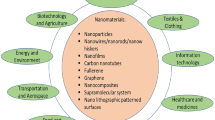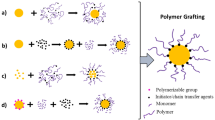Abstract
Organo-inorganic nanocomposite glassy films are obtained by the sol-gel method via hydrolytic polycondensation reactions of silicon and titanium alkoxides in solutions of polymers of different chemical compositions. The polymer structure and interaction with oxides in the films are investigated by FTIR spectroscopy, atomic force microscopy, using a particle size analyzer and a number of physicochemical methods. The presence of nanosized (from ∼20 to 370 nm) particles of the oxides in the structure of hybrid films is confirmed. It is shown that the best practically useful properties are exhibited by the composite films with strong organo-inorganic polymer-oxide networks. Such films may be used for creating membranes and sorbents for water purification from harmful organic and ionic admixtures.
Similar content being viewed by others
References
Graham, T., On the Properties of Silicic Acid and Other Analogous Colloidal Substances, J. Chem. Soc., 1864, vol. 16, no. 1, pp. 318–327.
Hench, L.L. and West, J.K., The Sol-Gel Process, Chem. Rev., 1990, no. 1, pp. 33–72.
Tian, D., Dubois, Ph., and Jerome, R., Biodegradable and Biocompatible Inorganic-Organic Hybrid Materials: 1. Synthesis and Characterization, J. Polym. Sci., Part A: Polym. Chem., 1997, vol. 35, no. 11, pp. 2295–2309.
Qiu, W., Luo, Y., Chen, F., Duo, Y., and Tan, H., Morphology and Size Control of Inorganic Particles in Polyimide Hybrids by Using SiO2-TiO2 Mixed Oxide, Polymer, 2003, vol. 44, pp. 5821–5826.
Yang, Y. and Wang, P., Preparation and Characterizations of a New PS/TiO2 Hybrid Membranes by Sol-Gel Process, Polymer, 2006, vol. 47, no. 8, pp. 2683–2688.
Sequeira, S., Evtuguin, D.V., Portugal, Y., and Esculcas, A.P., Synthesis and Characterization of Cellulose Hybrids Obtained Heteropoly Acid Catalysed Sol-Gel Process, Mater. Sci. Eng., C, 2007, vol. 27, no. 2, pp. 172–179.
Yang, Ya-N., Zhang, H-X., Wang, P., Zhang, M.-Y., Yang, H.-D., Hu, M.-Z., and Jin, J. Kinetic and Thermodynamic Research of Polysul-phone/TiO2 Hybrid Ultrafiltration Membrane, Acta Chim. Sin. (Engl. Ed.), 2007, vol. 65, no. 13, pp. 1258–1264.
Suvorova, A.I., Suvorov, A.L., Koryakova, O.V., and Zolotova, E.S., Hybrid Organic-Inorganic Films Polyvinyl Alcohol / Silicon Oxide, in Fiziko-khimiya polimerov. Sintez, svoistva i primenenie. Sbornik nauchnykh trudov (Physics and Chemistry of Polymers: Synthesis, Properties and Applications: Collection of Scientific Works), Tver: Tver State University, 2009 [in Russian].
Summ, B.D., Osnovy kolloidnoi khimii (Foundations of Colloid Chemistry), Moscow: Akademiya, 2006 [in Russian].
Fridrikhsberg, D.A., Kurs kolloidnoi khimii (Course of Colloid Chemistry), St. Petersburg: Lan, 2010.
Shapovalov, V.I., Nanopowders and Films of Titanium Oxide for Photocatalysis: A Review, Glass Phys. Chem., 2010, vol. 36, no. 2, pp. 145–194.
Suvorova, A.I., Tyukova, I.S., Orlova, T.I., and Nadol’skii, A.L., The Structure of the Organic-Inorganic Films of Polyamide-(SiO2)x, in “Tekhnicheskaya khimiya. Ot teorii k praktike.” Materialy mezhdunarodnoi konferentsii (Proceedings of the International Conference “Technical Chemistry: From Theory to Practice”), Perm, 2008, pp. 235–239.
Suvorova, A.I., Suvorov, A.L., Ivanenko, M.V., and Shishkin, E.I., Nanocomposite Membrane Films on the Basis of Ether of Cellulose and Tetraethoxysilane, Nanotechnol. Russ., 2009, vol. 4, no. 1–2, pp. 102–108.
Tyukova, I.S., Suvorova, A.I., Okuneva, A.I., and Shishkin, E.I., Preparation and Structure of Chitosan-Silica Organic-Inorganic Hybrid Films, Polym. Sci., Ser. B, 2010, vol. 52, no. 9, pp. 1702–1708.
Adamson, A.W., Physical Chemistry of Surfaces, New York: Wiley, 1977. Translated under the title Fizicheskaya khimiya poverkhnostei, Moscow: Mir, 1979.
Bellamy, L.J., The Infrared Spectra of Complex Molecules, London: Methuen, 1958. Translated under the title Infrakrasnye spektry slozhnykh molekul, Moscow: Inostrannaya Literatura, 1963.
Voronkov, M.G., Mileshkevich, V.P., and Yuzhelevskii, Yu.A., Siloksanovaya svyaz’ (Siloxane Bond), Moscow: Nauka, 1976 [in Russian].
Yoldas, B.E., Hydrolysis Titanium Alkoxide and Effects of Hydrolytic Polycondensation Parameters, J. Mater. Sci., 1986, vol. 21, pp. 1087–1092.
Crini, G., Recent Developments in Polysaccharide-Based Materials Used as Adsorbents in Water Treatment, Prog. Polym. Sci., 2005, vol. 30, no. 1, pp. 38–70.
Lipatov, Yu.S., Fiziko-khimicheskie osnovy napolneniya polimerov, Moscow: Khimiya, 1972. Translated under the title Physical Chemistry of Filled Polymers, London: Rubber and Plastics Research Association of Great Britain, 1979.
Ivanchev, S.S. and Ozerin, A.N., Nanostructures in Polymer Systems, Polym. Sci., Ser. B, 2006, vol. 48, no. 8, pp. 213–225.
Bhanushali, D., Kloos, S., and Bhattacharyya, D., Solute Transport in Solvent-Resistant Nanofiltration Membranes for Non-Aqueous Systems: Experimental Results and Role of Solute-Solvent Coupling, J. Membr. Sci., 2002, vol. 208, no. 2, pp. 343–359.
Malkin, A.Ya. and Chalykh, A.E., Diffuziya i vyazkost’ polymerov: Metody izmereniya (Diffusion and Viscosity of Polymers: Methods of Measurement), Moscow: Khimiya, 1979 [in Russian].
Osadchii, Yu.P. and Nevskii, A.V., Mathematical Modeling of Separation of Waste Water Containing Dyes, Ekol. Prom-st. Ross., 2009, no. 3, pp. 46–48.
Vrednye khimicheskie veshchestva. Neorganicheskie elementy I–IV gruppy: Spravochnik (Harmful Chemicals. Inorganic Elements I–IV Group: A Handbook), Filov, V.A., Ed., Leningrad: Khimiya, 1988 [in Russian].
Parashchuk, V.V. and Volkov, A.V., Polymeric Materials and Membranes for Nanofiltration of Organic Media, Krit. Tekhnol., Ser.: Membr., 2008, no. 1, pp. 25–34.
Author information
Authors and Affiliations
Corresponding author
Additional information
Original Russian Text © A.I. Suvorova, I.S. Tyukova, A.L. Suvorov, 2011, published in Fizika i Khimiya Stekla.
Rights and permissions
About this article
Cite this article
Suvorova, A.I., Tyukova, I.S. & Suvorov, A.L. Polymer organic-inorganic materials for membrane technology, their characteristics and properties. Glass Phys Chem 37, 629–639 (2011). https://doi.org/10.1134/S1087659611060198
Received:
Published:
Issue Date:
DOI: https://doi.org/10.1134/S1087659611060198




